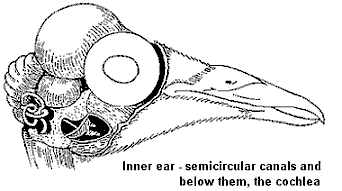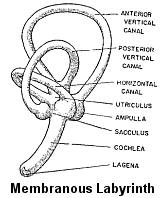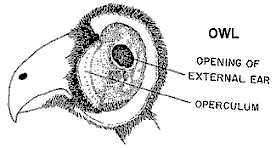The Avian Ear Part I addressed the anatomy of the avian ear. Part II explains how birds hear and discusses some of the more common diseases of the ear.
 How Birds Hear
How Birds Hear
Sound waves are directed by the specialized auricular feathers surrounding the external ear and funneled towards the opening of acoustic/auditory meatus.
Sound waves enter the middle ear as mechanical vibrtions and produce movement or vibration of the tympanic membrane (eardrum).
These mechanical vibrations are then transported by the collumella or bony ossicle to the membranous oval window in the inner ear. Mechanical vibrations in the oval window cause vibrtions in the fluid of the inner ear. The inner ear is the sensory receptor for sound and equilibrium.
 These vibrations are transmitted to sensory cells of the cochlear duct by the perilymph within the vestibule and its scale.
These vibrations are transmitted to sensory cells of the cochlear duct by the perilymph within the vestibule and its scale.
The eighth cranial nerve or auditory nerve carries impulses from the ear to the brain.
Hearing in birds is dependent upon the cochlear of the inner ear. The auditory receptor of the cochlear is the organ of corti. It rests on a basilar membrane that contains sensitive hair cells. When the endolymph vibrates in response to movements of the columella against th oveal window, vibrtions stimulate the hair cells. Impulses are transmitted from the hair cells to the brain where they are interpreted as sounds of different pitches.
Diseases of the Ear
Ear problems are not very common in birds. Occlusion of the external openings may occur in macaws. Macaws hatch with a thin membrane covering their ear canals. This membrane should start to open in 12-35 days. If it does not, it must be opened surgically.
Otitis externa is an inflammation of the external ear. It may by caused by bacterial or fungal organisms. Pruitis or itching may be present, causing the bird to scratch his ear or rub his head on the perch. The ear opening may be swollen and red and the feathers may be matted with a discharge.
Viral diseases such as paramyxo virus can cause otitis interna, resulting in loss of balance and torticollis (abnormal twisted head position – head turned upside down.)
Neoplasia can affect the ears. Carcinoma of the ceruminous gland of the ear is the most common neoplasm – and must be differentiated from chronic infection.
The ears of birds can be examined by skull x-rays, visual inspection and endoscopy. Abnormalitites can be further diagnosed by cultures and cytology.


 How Birds Hear
How Birds Hear